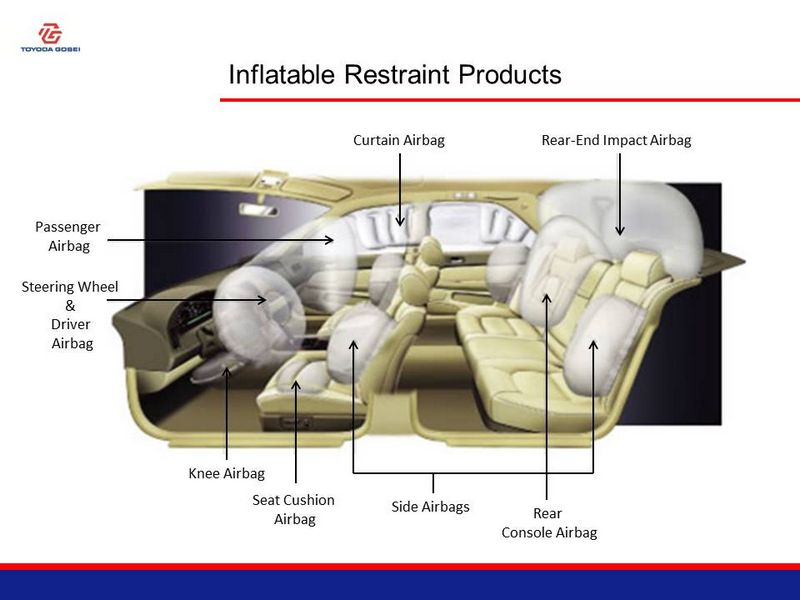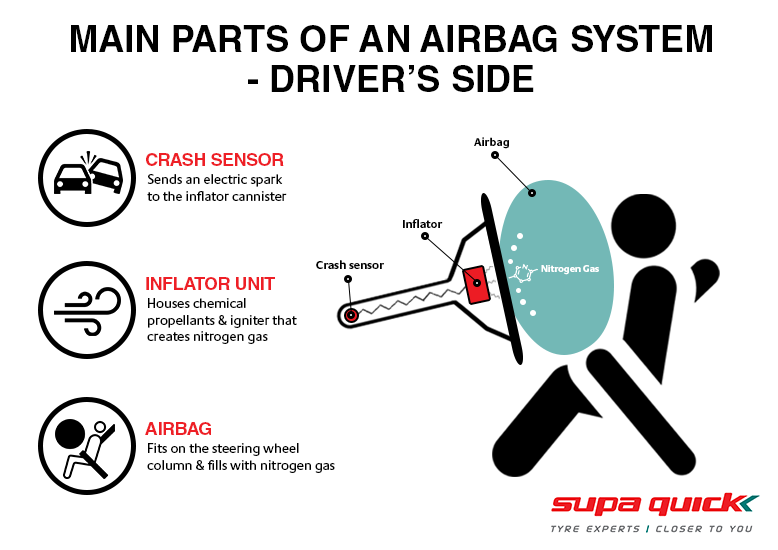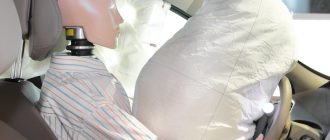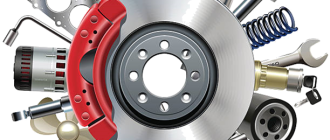
How Do Airbags Work to Protect Passengers in Car Accidents?
In today’s world, safety is of utmost importance, especially when it comes to car accidents. Every year, millions of people are injured or even killed in car accidents. That’s why car manufacturers have been constantly working on improving safety features, and one of the most important inventions in this field is the airbag.
Airbags are inflatable cushions that are designed to protect passengers in the event of a car accident. They work by deploying rapidly when a collision occurs, providing a soft and protective barrier between the passengers and the hard surfaces inside the car.
When the car’s sensors detect a significant impact, they send a signal to the airbag system, which triggers the inflation process. Within milliseconds, the airbag inflates with a mixture of gas and powder, creating a cushion that can absorb the force of the impact and reduce the risk of injury to the passengers.
It’s important to note that airbags are not meant to replace seatbelts, but rather to complement them. Seatbelts are still the primary safety feature in a car and should always be worn. Airbags work in conjunction with seatbelts to provide an additional layer of protection, especially in frontal crashes.
In conclusion, airbags play a crucial role in car safety by protecting passengers from the impact of accidents. Their inflatable design allows them to rapidly deploy and create a cushion, reducing the risk of severe injuries. However, it’s essential to remember that airbags are just one part of a comprehensive safety system, and seatbelt usage remains vital for maximum protection.
Importance of Airbags in Car Safety
In today’s world, car accidents are unfortunately a common occurrence. However, thanks to advancements in technology, we have airbags in cars that play a crucial role in protecting passengers during these accidents. Airbags work as a cushion to reduce the impact of a collision and minimize the chances of serious injuries.
How do airbags work?
When a car gets involved in an accident, the airbags are designed to deploy instantly. They are triggered by sensors located throughout the vehicle, which detect the rapid deceleration that occurs during a crash. Once deployed, the airbags provide a soft pillow-like cushion for the passengers in the car, which helps to absorb the force of impact and slow down their forward movement. This prevents the passengers from hitting hard surfaces within the car, such as the dashboard or windshield, which could cause severe injuries.
The importance of airbags in car safety:
- Protection for passengers: The primary purpose of airbags is to protect passengers. They can greatly reduce the risk of head, chest, and other critical injuries that can occur during a car accident.
- Minimize impact: Airbags work by absorbing the force of impact and spreading it out over a larger area. This helps to distribute the force more evenly and reduce the likelihood of serious injuries.
- Complement seat belts: Airbags work in conjunction with seat belts to provide maximum protection to passengers. Seat belts hold passengers in place, while airbags cushion their impact in case of a collision.
- Save lives: Studies have shown that airbags can significantly reduce the risk of fatal injuries in car accidents. The quick deployment and cushioning effect provided by airbags have saved countless lives over the years.
Conclusion:
Airbags are a crucial part of car safety systems and have proven to be highly effective in protecting passengers during accidents. They provide an additional layer of protection and work alongside seat belts to minimize the risk of severe injuries. Investing in cars equipped with airbags is a smart choice and can greatly increase the safety of both drivers and passengers on the road.
History of Airbags
The development of airbags is an important milestone in automotive safety. Airbags, designed to protect passengers in car accidents, have come a long way since their inception. Let’s take a closer look at their history.
- Early concepts: The idea of using airbags to cushion the impact of accidents can be traced back to the mid-20th century. In the 1950s, engineers began experimenting with inflatable devices that could protect occupants in different scenarios. However, these early airbags were not as effective as the ones we have today.
- First commercial application: In the 1970s, General Motors (GM) became the first car manufacturer to introduce airbags in their vehicles. GM’s airbags were designed to protect drivers in frontal collisions. While they were a significant step towards improving car safety, these early airbags had limited features compared to the ones available today.
- Advancements and regulations: Throughout the 1980s and 1990s, airbag technology continued to evolve. Automakers began incorporating airbags for passengers and implementing more sophisticated sensors to detect accident conditions. Additionally, governments around the world started mandating airbags in vehicles to enhance passenger safety.
- Multi-stage airbags: In the 2000s, car manufacturers started implementing multi-stage airbags. These airbags use advanced sensors to determine the severity of the impact and deploy accordingly. This technology allows for a more customized response based on the specific accident conditions, further increasing passenger safety.
- Current innovations: Today, airbag technology continues to advance. Manufacturers are working on developing airbags that can protect occupants in various accident scenarios, such as side impacts or rollovers. Additionally, research is ongoing to improve sensor technology and reduce the risk of airbag-related injuries.
In conclusion, the history of airbags showcases the ongoing efforts to enhance passenger safety in car accidents. From early concepts to modern innovations, airbags have revolutionized car safety and continue to protect passengers worldwide.
Components of an Airbag System
The inflatable airbags in cars are an essential safety feature that help protect passengers in the event of accidents. A typical airbag system consists of several components that work together to cushion and protect the occupants of the car.
- Airbag Module: This is the central component of the airbag system. It consists of an inflatable airbag made of a durable fabric that can expand rapidly when filled with gas.
- Crash Sensors: These sensors are strategically placed throughout the car and are designed to detect sudden changes in acceleration or deceleration. When a significant impact is detected, the crash sensors send signals to the airbag control unit.
- Airbag Control Unit: This electronic unit receives signals from the crash sensors and determines whether to deploy the airbags. It processes the data to calculate the severity of the impact and activates the airbags if necessary.
- Igniter: This device is responsible for igniting the solid propellant that generates the gas needed to inflate the airbag. When the airbag control unit determines that deployment is necessary, it sends an electrical current to the igniter, which then initiates the combustion process.
- Gas Generator: The gas generator is a canister filled with solid propellant. When the igniter ignites the propellant, a chemical reaction occurs, producing a large volume of gas. This gas rapidly inflates the airbag, allowing it to cushion the passengers during a collision.
The components of an airbag system work in a synchronized manner to ensure the safety of car passengers during accidents. The crash sensors detect the impact, the airbag control unit analyzes the data, and when necessary, it triggers the deployment of the airbags. The gas generator then rapidly inflates the airbags to create a cushioning effect and protect the passengers from injury.
Sensor System that Triggers Airbags
The sensor system plays a crucial role in the functioning of airbags in a car. It is responsible for detecting accidents or sudden changes in speed and relaying this information to the airbag control unit.
Safety First
Car airbags are designed to be a safety measure to protect passengers in case of accidents. The sensor system ensures that the airbags deploy at the right time to offer the necessary cushion and prevent severe injuries.
How Do They Work?
The sensor system primarily consists of sensors placed strategically around the vehicle. These sensors are designed to detect various factors that could indicate a crash or sudden impact.
Crash Sensors
Crash sensors are the most important part of the airbag sensor system. They detect significant changes in velocity, sudden deceleration, or acceleration that could indicate a collision or accident. These sensors measure vehicle speed, direction, and G-forces to determine the severity of the accident.
Occupancy Sensors
In addition to crash sensors, some vehicles are equipped with occupancy sensors. These sensors detect the presence of passengers and their weight in order to adjust the deployment of airbags accordingly. For example, if a child is seated in the front passenger seat, the airbag may be disabled to prevent injury.
Side Impact Sensors
Side impact sensors are placed on the sides of the vehicle and are designed to detect any significant impact on the car’s body. These sensors help in deploying side airbags to protect passengers from injuries in case of a side collision.
Electronic Control Unit
All the information collected by the sensors is sent to the electronic control unit (ECU). The ECU processes this data and determines if the airbags should be deployed. If the ECU determines that the impact is severe enough to warrant airbag deployment, it sends a signal to the airbag inflator module.
Inflatable Protection
Once the signal is received, the airbag inflator module initiates a controlled explosion that inflates the airbags within milliseconds. The inflated airbags serve as a cushion between the passengers and the car’s interior, reducing the impact and protecting them from injuries during a collision.
Conclusion
The sensor system in car airbags is a critical component of passenger safety. By detecting and analyzing various factors, these sensors ensure that the airbags work effectively in protecting passengers during accidents. Properly functioning sensors and airbags can significantly reduce the severity of injuries and save lives.
How Do Airbags Inflate?
Airbags are an essential safety feature in cars, designed to protect passengers in the event of accidents. They work by rapidly inflating to provide a cushioning effect, reducing the impact forces during a collision and minimizing the risk of severe injuries.
The process of inflating an airbag is initiated by sensors in the car’s safety system. These sensors detect the sudden deceleration caused by a car accident and send a signal to the airbag module to deploy the airbags. Once the signal is received, the inflator, which is a device filled with a mixture of chemicals, is activated.
The chemicals inside the inflator, usually sodium azide and potassium nitrate, undergo a rapid chemical reaction when triggered. This reaction produces a large volume of nitrogen gas, which fills the airbag within milliseconds. The nitrogen gas quickly inflates the airbag, allowing it to deploy and provide a protective cushion for the passengers.
The inflators in newer cars also include filters to remove any potentially harmful byproducts generated during the chemical reaction. This ensures that the gas filling the airbag is clean and safe for the occupants.
After inflation, the airbag remains inflated for a short period of time, allowing the occupant to absorb the impact and be protected from secondary collisions. Once the initial impact forces have dissipated, the gas is slowly released through small vents in the fabric of the airbag, gradually deflating it.
It’s important to note that airbags should always be used in conjunction with seat belts, as they work together to provide optimum protection for passengers. While airbags can significantly reduce the risk of injuries in car accidents, they are not a substitute for seat belts.
In conclusion, airbags inflate rapidly using a chemical reaction triggered by sensors in the car’s safety system. The gas produced during the reaction fills the airbag, creating a cushion to protect passengers from the impact forces of a car accident.
Types of Airbags
Inflatable cushions known as airbags are an essential safety feature in cars that help protect passengers during accidents. These airbags are designed to deploy rapidly in the event of a collision, creating a cushion between the occupants and the hard surfaces of the car.
There are several types of airbags used in cars today. Each type is strategically placed throughout the vehicle to provide the best protection in various types of accidents. Here are some common types of airbags:
- Frontal Airbags: These airbags are typically located in the steering wheel and dashboard of the car. They are designed to protect the driver and front passenger in the event of a head-on collision. When a crash occurs, the front sensors detect the impact and trigger the airbags to inflate within milliseconds.
- Side Airbags: Side airbags are usually located in the door panels or the sides of the seats. They provide protection in the event of a side impact collision. Side airbags can help protect the chest, pelvis, and head from injuries by absorbing the energy of the impact and preventing the occupants from hitting hard surfaces inside the car.
- Curtain Airbags: Curtain airbags, also known as roof-mounted airbags, are designed to provide protection for the head and neck area. They are usually found along the roofline of the vehicle and cover the side windows. In the event of a rollover or side impact collision, these airbags deploy to create a protective curtain, reducing the risk of head injuries for both front and rear passengers.
- Knee Airbags: Knee airbags are positioned below the steering column and on the dashboard. They are specifically designed to protect the knees and lower legs of the driver and front passenger during a frontal collision. These airbags help prevent injuries by reducing the impact force on the lower extremities.
It is important to note that the exact placement and type of airbags may vary depending on the make and model of the car. Additionally, newer cars may feature advanced systems with multiple airbags and sensors that can analyze the severity of the crash and adjust the deployment of the airbags accordingly.
In summary, airbags work in conjunction with seat belts to provide effective protection for car occupants in the event of an accident. Different types of airbags are strategically placed throughout the car to mitigate injuries and increase overall safety for passengers.
Frontal Airbags
Frontal airbags are inflatable cushions that are designed to protect passengers in a car during a frontal collision. They are a crucial part of a car’s safety system and work in tandem with seat belts to minimize the risk of injury.
Frontal airbags are located in the steering wheel for the driver and in the dashboard for the front passenger. When a collision occurs, the airbags deploy rapidly, creating a cushioning effect that absorbs the force of the impact and helps to prevent the occupants from hitting hard surfaces inside the car.
The airbags are made of a thin, but strong, fabric that is folded and packed into the steering wheel or dashboard. When triggered by sensors in the car’s crash detection system, the airbags rapidly inflate with a mixture of gas and a small amount of explosive material.
The inflation process happens in milliseconds, which is why they are able to protect passengers so effectively. As the airbags fill with gas, they quickly expand and create a barrier between the passengers and the car’s interior. This reduces the risk of head and chest injuries and distributes the force of the impact more evenly across the body.
It’s important to note that frontal airbags are designed to work together with seat belts, not replace them. Airbags provide an additional layer of protection and are most effective when used in conjunction with properly fastened seat belts. Together, airbags and seat belts can significantly reduce the risk of serious injury or death in a car accident.
Frontal airbags have come a long way in terms of safety and technology since they were first introduced in the 1970s. The development of advanced sensors and crash detection algorithms have made airbags more reliable and effective than ever before.
In conclusion, frontal airbags are an essential safety feature in cars that help protect passengers during frontal collisions. By rapidly inflating and creating a cushioning effect, they reduce the risk of head and chest injuries and distribute the force of the impact more evenly. Remember to always wear your seat belt and ensure that your airbags are properly maintained for maximum safety.
Side Airbags
Side airbags are an important safety feature in cars that work alongside frontal airbags to provide additional protection to passengers in the event of an accident. While frontal airbags are designed to cushion the impact in a head-on collision, side airbags are specifically designed to protect occupants during side-impact accidents.
Side airbags are inflatable cushions that are installed in the door panels, seatbacks, or side curtain areas of a car. They are typically made of strong and flexible fabric that can quickly inflate in the event of a crash. Once inflated, side airbags create a barrier between the occupants and the door, reducing the risk of injury.
One common type of side airbag is the thorax airbag, which is located on the sides of the seats and provides protection to the chest and upper body. Another type is the curtain airbag, which deploys from the roof lining and covers the side windows, providing protection to the head in the event of a rollover or side-impact collision.
Side airbags work by using sensors located throughout the car to detect a side impact. These sensors measure the force and direction of the impact and send a signal to the airbag control module. The control module then activates the appropriate side airbags, which inflate within milliseconds to cushion the occupants.
It is important to note that side airbags are not meant to replace seat belts, but rather to work together with them to provide maximum protection in an accident. Seat belts hold the occupants in place, preventing them from being thrown around the car, while side airbags add an extra layer of cushioning to reduce the risk of injury.
- Side airbags are an essential component of a car’s safety system.
- They inflate quickly to protect occupants during side-impact accidents.
- There are different types of side airbags, including thorax and curtain airbags.
- Sensors detect a side impact and activate the appropriate side airbags.
- Side airbags work in conjunction with seat belts to provide maximum protection.
Curtain Airbags
Curtain airbags are a type of safety feature in cars that work alongside other airbags to protect passengers in case of a car accident. They are designed to cushion and protect the heads of passengers, especially those seated closer to the windows.
Similar to other airbags, curtain airbags are inflatable devices that rapidly deploy in the event of a collision to provide a cushioning effect. However, what sets them apart is their location and the way they deploy. Curtain airbags are typically located in the roofline above the side windows and deploy downwards, covering the entire window area.

When a collision occurs, sensors within the car detect the impact and send a signal to the airbag control unit. The control unit then triggers the deployment of the curtain airbags along with other relevant airbags. The curtain airbags instantly inflate with gas, forming a protective barrier between the passengers and the window area.
The purpose of curtain airbags is to prevent the passengers’ heads from making direct contact with the window or any objects that may enter the car during a side impact. By providing a cushioning effect, curtain airbags help reduce the risk of head injuries, such as concussions or skull fractures.
It is important to note that curtain airbags work in conjunction with other safety features in a car, such as seat belts and frontal airbags. Together, these safety features aim to provide comprehensive protection for the passengers in different types of accidents.
|
In summary, curtain airbags are inflatable safety devices in cars that protect passengers in case of side impact collisions. They provide a cushioning effect and help prevent head injuries by deploying from the roofline above the side windows. Together with other safety features, curtain airbags aim to enhance passenger safety in car accidents.
Knee Airbags
In addition to the standard airbags found in the steering wheel and dashboard, many modern cars are equipped with knee airbags. Knee airbags are designed to provide an extra measure of protection for the driver and front passenger in the event of a car accident.
Knee airbags work by deploying from the lower part of the dashboard, underneath the steering column. When a car collision occurs, sensors in the vehicle detect the impact and send a signal to the airbag system. The knee airbags then rapidly inflate, forming a cushion that helps to prevent the driver or front passenger’s knees from hitting the dashboard.
By providing an additional layer of safety, knee airbags can help to reduce the risk of knee and leg injuries in car accidents. They can also help to distribute the forces of impact more evenly throughout the body, minimizing the risk of more severe injuries to the head, chest, and abdomen.
It’s worth noting that knee airbags are designed to work in conjunction with other safety features, such as seatbelts and frontal airbags. Together, these systems provide a comprehensive safety net for occupants of the car in the event of a collision.
The inflatable nature of knee airbags allows them to rapidly deploy and provide protection within milliseconds of a crash. The airbags are made from a strong, tear-resistant fabric and are filled with gas to provide the necessary cushioning. Once deployed, the airbags quickly deflate to allow for easy exit from the vehicle.
Overall, knee airbags are an important safety feature in modern cars. They provide an additional layer of protection to the driver and front passenger, helping to minimize the risk of injury in car accidents. By working in conjunction with other safety systems, knee airbags contribute to making cars safer for occupants.
Seatbelt Airbags
Seatbelt airbags are an important addition to the safety features in cars. They work in conjunction with regular airbags to provide an extra layer of protection for passengers in the event of a car accident.
These airbags are designed to cushion and protect the occupants in case of a collision. They are built into the seatbelt itself, so they deploy from the belt instead of the dashboard or steering wheel like regular airbags. This positioning ensures that the airbag is in the correct place to provide maximum protection to the passenger.
Seatbelt airbags work by using sensors to detect when a collision has occurred. Once the sensors detect a crash, the airbags inflate rapidly to create a cushioning effect for the passengers. This helps to distribute the force of the impact more evenly across the body, reducing the risk of injury.
The purpose of seatbelt airbags is to further enhance the safety of the occupants in a car. When used in conjunction with regular airbags, they provide a comprehensive safety system that can greatly reduce the risk of serious injury or even death in a car accident.
It is important to note that seatbelt airbags are not a replacement for seatbelts themselves. They are designed to work in conjunction with seatbelts, so it is crucial for passengers to always wear their seatbelts properly. Seatbelt airbags are just one additional layer of protection that can help to further enhance the safety of passengers in the event of an accident.
In conclusion, seatbelt airbags are an important part of car safety. They work alongside regular airbags to provide an extra level of protection for passengers in the event of a collision. By cushioning and distributing the force of impact, seatbelt airbags help to reduce the risk of injury in accidents. It is crucial for passengers to always wear their seatbelts properly to ensure the full effectiveness of seatbelt airbags and other safety features in the car.
Advanced Airbag Technologies
With the constant advancements in automotive technology, airbags have become much more than just a cushion in the event of accidents. These advanced airbag technologies are designed to provide enhanced safety for car passengers and work together with other safety features to protect them in case of emergencies.
- Smart Airbags: Traditional airbags deploy with the same force, regardless of the severity of the accident. However, smart airbags have sensors that can measure the impact of a collision and adjust the deployment force accordingly. This helps prevent injuries that may occur from the excessive force of the airbag.
- Side-Impact Airbags: These airbags are specially designed to protect passengers in the event of a side-impact collision. They are usually deployed from the seat or door and provide a cushion to minimize the risk of injury to the head and torso.
- Knee Airbags: Knee airbags are positioned beneath the dashboard and are intended to protect the lower limbs of occupants. They provide additional protection in a crash by preventing injuries to the knees and legs.
- Curtain Airbags: Curtain airbags, also known as roof-mounted airbags, deploy from above the windows and create a protective barrier during a rollover or side-impact collision. They help minimize the risk of head injuries by providing a cushion between the occupant’s head and the vehicle’s interior.
- Multi-stage Airbags: Multi-stage airbags can deploy at different speeds and pressures, depending on the severity of the crash. This allows for a custom-tailored response to different types of accidents, providing the optimal level of protection for passengers.
These advanced airbag technologies, along with proper seat belt usage, play a critical role in ensuring the safety of car passengers in accidents. They work together to protect occupants from the impact forces and reduce the risk of severe injuries. Car manufacturers continue to innovate and improve airbag technologies to provide even greater safety measures in modern vehicles.
Limitations and Considerations
While airbags are an important safety feature in cars, they do have certain limitations and considerations that passengers should be aware of. Understanding these limitations can help passengers make informed decisions about their own safety.
- Not a Cushion for All Accidents: Airbags are designed to work in conjunction with seat belts to protect passengers during frontal or near-frontal accidents. They are not meant to protect passengers in all types of accidents, such as side impacts or rollovers. It is important for passengers to always wear their seat belts, as seat belts provide overall protection in a variety of accident scenarios.
- Size and Positioning: Airbags are designed for adult-sized occupants who are properly seated in the car. Children and smaller individuals may not be positioned correctly for optimal airbag protection. It is important to follow car seat and restraint guidelines for children to ensure their safety in the event of an accident.
- Deployment Force: Airbags deploy with a significant amount of force in order to provide adequate protection. This force can cause minor injuries, such as abrasions or bruises. Passengers should always sit upright and maintain a safe distance from the airbags to minimize the risk of injury.
- Effectiveness: While airbags can greatly enhance passenger safety, they are not foolproof and may not fully protect all occupants in every accident. Factors such as the severity of the impact, the size and position of the passengers, and the condition of the airbags can all affect their effectiveness. It is important to remember that airbags are just one component of a car’s overall safety system.
|
|
Overall, airbags are an important safety feature in cars that can greatly enhance passenger protection in frontal or near-frontal accidents. However, it is essential to understand their limitations and consider other safety measures, such as properly wearing seat belts and following car seat guidelines for children, to ensure optimal safety in all types of accidents.
Airbag Safety and Regulations
Airbags are inflatable cushions in a car that work to protect passengers in case of accidents. While they are designed to save lives, it is important to follow certain safety regulations and guidelines to ensure their effectiveness.
1. Proper Usage:
- Always wear a seatbelt in addition to relying on airbags for protection. Airbags are designed to work in conjunction with seatbelts, not as a standalone safety measure.
- Keep a distance of at least 10 inches between yourself and the airbag. Sitting too close to the airbag can increase the risk of injury when it deploys.
- Children under the age of 13 should always ride in the back seat. Airbags can be dangerous for young children, and they should be properly restrained in age-appropriate car seats.
- Never place objects or accessories on or near the airbag cover. In case of deployment, these objects can become projectiles and cause harm.
2. Types of Airbags:
There are different types of airbags in a car, and each one serves a specific purpose.
- Frontal airbags: These are located in the steering wheel and dashboard and are designed to protect the driver and front-seat passengers in head-on collisions.
- Side airbags: These are located in the doors or seats and are designed to protect occupants in side-impact accidents.
- Head curtain airbags: These are located in the roofline and deploy to protect the heads of occupants in side-impact or rollover accidents.
3. Safety Regulations:
Car manufacturers must adhere to strict safety regulations regarding airbag deployment:
- Airbags must deploy within a fraction of a second after a crash is detected, cushioning the impact for passengers.
- They must deflate quickly to prevent suffocation or injury to passengers.
- Manufacturers must conduct rigorous crash tests to ensure the effectiveness of airbags in varying accident scenarios.
- There are regulations regarding the materials used in airbags to minimize the risk of fire or other hazards.
In conclusion, airbags play a crucial role in protecting passengers during car accidents. It is important to follow the safety regulations and guidelines to ensure their proper functioning and maximize passenger safety.
Questions and answers:
What is an airbag?
An airbag is a safety device designed to protect passengers in a car during a collision. It is made of a flexible fabric and is located on the dashboard, steering wheel, and sometimes on the sides of the car.
How does an airbag work?
When a car is involved in a collision, sensors detect the impact and send a signal to the airbag control unit. The control unit then triggers the release of a chemical reaction that rapidly inflates the airbag with gas. The inflated airbag provides a cushion for the passengers, reducing the force of impact and preventing them from hitting hard surfaces in the car.
What happens when the airbag is deployed?
When the airbag is deployed, it inflates within milliseconds, usually faster than the blink of an eye. It creates a barrier between the passenger and the hard surfaces of the car, such as the steering wheel or dashboard. The force of impact is absorbed by the airbag, reducing the risk of injuries to the head, chest, and torso.
Are airbags always effective?
Airbags are designed to work in conjunction with seat belts. Seat belts help to keep passengers in a secure position so that the airbag can provide maximum protection. However, the effectiveness of airbags can vary depending on the specific circumstances of the collision, the position of the passengers, and other factors. It is important to always wear seat belts and follow other safety precautions while driving.
Do all cars have airbags?
Not all cars have airbags, especially older models. However, in many countries, it is now mandatory for new cars to be equipped with airbags as part of the safety standards. Airbags have been proven to save lives and reduce the severity of injuries in car accidents, so their inclusion in vehicles is highly recommended.





